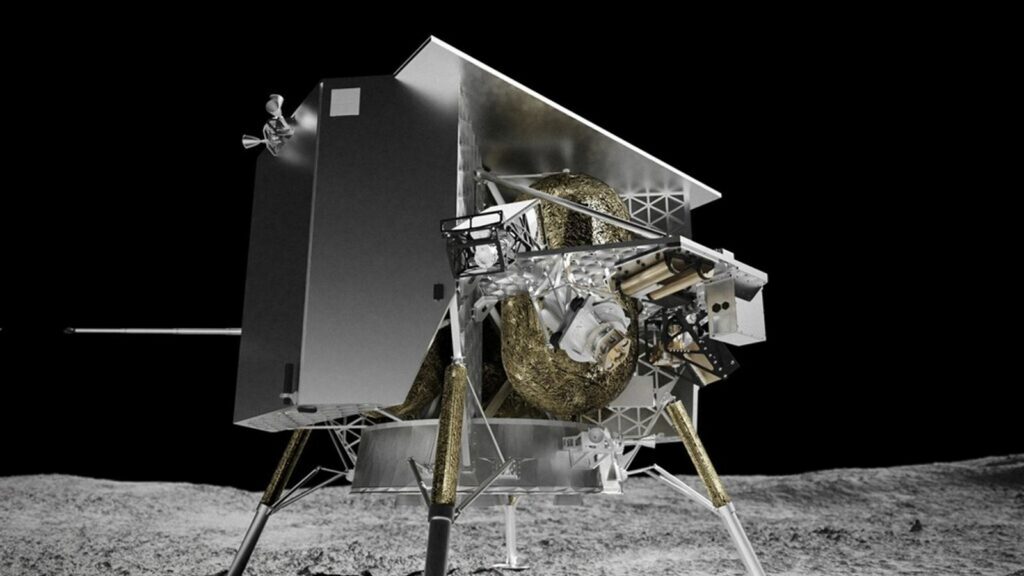Doomed Peregrine moon lander to be allowed to burn up in Earth’s atmosphere, says Astrobotic | World News

The spacecraft which attempted the first US moon landing in more than 50 years is to be allowed to “burn up” during re-entry into Earth’s atmosphere, the company behind the mission has said.
Pittsburgh-based Astrobotic said it had made the “difficult decision” to maintain the craft’s trajectory and was working with NASA and the space community to take the “safe and responsible” course of action.
The Peregrine lander developed a “critical” fuel leak hours after its launch from Cape Canaveral Space Force Station, Florida, on 8 January.
The company said it had been “evaluating” the best and safest way to end the mission to ensure the protection of satellites and not create debris in cislunar space – the area between the Earth and the outer reaches of the moon’s orbit.
Astrobotic had aimed for a soft lunar landing on 23 February and to become the first private company to complete such a mission – but said last week there was “no chance” it would achieve its goal following the propellant leak.
One of the first images of Peregrine in space. Pic: Astrobotic
In an update, Astrobotic said: “The recommendation we have received is to let the spacecraft burn up during re-entry in Earth’s atmosphere.
“Since this is a commercial mission, the final decision of Peregrine’s final flight path is in our hands.
“Ultimately, we must balance our own desire to extend Peregrine’s life, operate payloads, and learn more about the spacecraft, with the risk that our damaged spacecraft could cause a problem in cislunar space.
“As such, we have made the difficult decision to maintain the current spacecraft’s trajectory to re-enter the Earth’s atmosphere.
“By responsibly ending Peregrine’s mission, we are doing our part to preserve the future of cislunar space for all.”
The mission is expected to reach its conclusion on Thursday, according to Astrobotic CEO, John Thornton.
“This mission has already taught us so much and has given me great confidence that our next mission to the moon will achieve a soft landing,” he added.
Read more:
NASA offers chance to send your name to the moon
First successful landing on moon’s south pole
NASA had paid Astrobotic $108m (£85m) to fly a range of experiments to the moon on the Peregrine mission as part of the agency’s commercial lunar programme.
It said on its website: “Spaceflight is an unforgiving environment, and we commend Astrobotic for its perseverance and making every viable effort to collect data and show its capabilities of Peregrine while in flight. Together, we will use the lessons learned to advance CLPS.”
Earlier, the space agency had said that several of the experiments had been able to operate in space, despite the mission being unable to land on the moon.
This content is provided by X, which may be using cookies and other technologies.
To show you this content, we need your permission to use cookies.
You can use the buttons below to amend your preferences to enable X cookies or to allow those cookies just once.
You can change your settings at any time via the Privacy Options.
Unfortunately we have been unable to verify if you have consented to X cookies.
To view this content you can use the button below to allow X cookies for this session only.
Allow Cookies Once
Postings on X from Astrobiotic suggest it travelled as far from the Earth as the moon but was not able to enter its orbit, and it then began to head back towards the planet.
A second lander from a Houston company is due to launch a similar mission next month.
Recent Posts
- Pullman Hotels & Resorts reveals the ultimate blended travel space – The Transforming Room
- World of Hyatt and Headspace Launch New Series to Help Travelers Find A Good Night’s Sleep
- Influencers signed up as Abta kicks off pre-peaks promotion
- Peter Island Resort Set for December Debut in the British Virgin Islands
- PM Hotel Group Expands Washington, DC Area Portfolio With Management of Three Hotels





Recent Comments